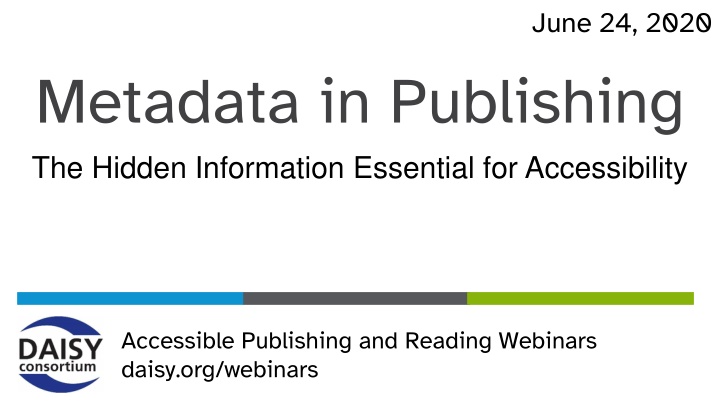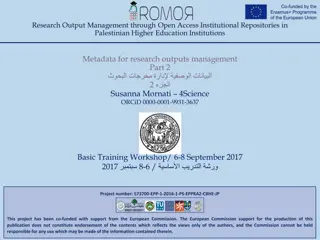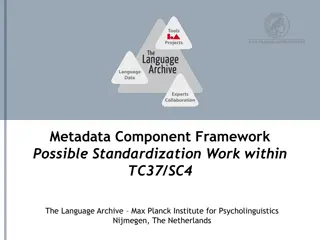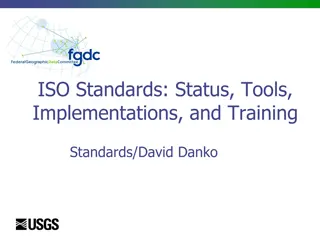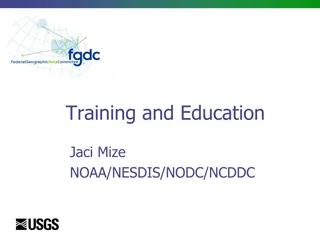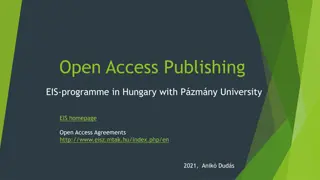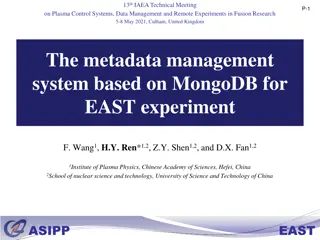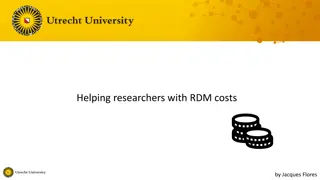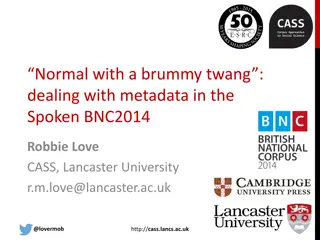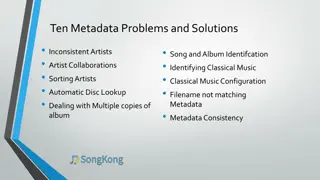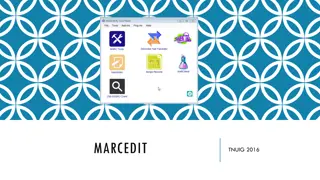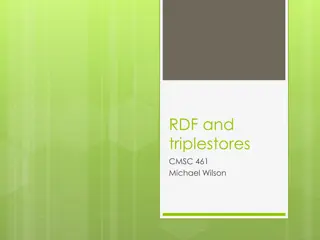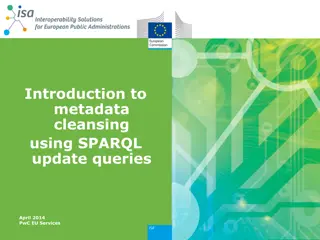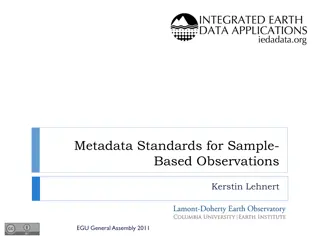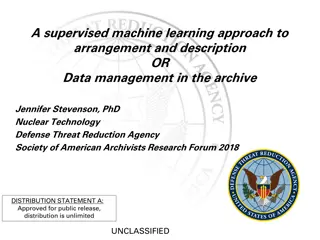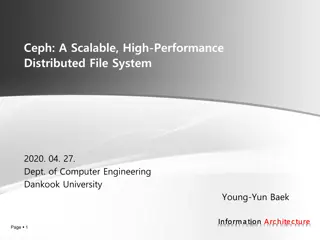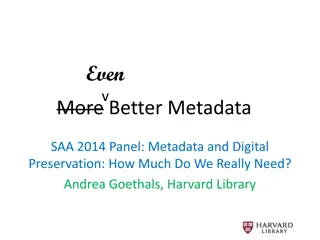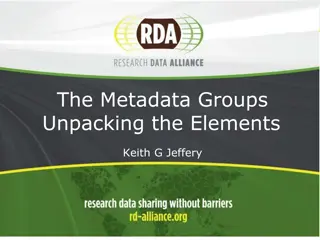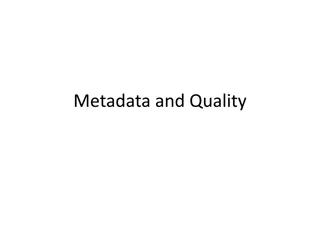Metadata in Publishing
"This content delves into the crucial role of metadata in publishing for enhancing accessibility. Experts discuss accessibility metadata in EPUB, ONIX, library formats, and more, aiming to improve inclusivity and usability of publications. Learn about different types of EPUBs, discoverable vs. accessible vs. optimized, and the significance of discovery metadata in describing a publication's content comprehensively."
Download Presentation

Please find below an Image/Link to download the presentation.
The content on the website is provided AS IS for your information and personal use only. It may not be sold, licensed, or shared on other websites without obtaining consent from the author.If you encounter any issues during the download, it is possible that the publisher has removed the file from their server.
You are allowed to download the files provided on this website for personal or commercial use, subject to the condition that they are used lawfully. All files are the property of their respective owners.
The content on the website is provided AS IS for your information and personal use only. It may not be sold, licensed, or shared on other websites without obtaining consent from the author.
E N D
Presentation Transcript
June 24, 2020 Metadata in Publishing The Hidden Information Essential for Accessibility Accessible Publishing and Reading Webinars daisy.org/webinars
Your panel Host: Richard Orme Madeleine Rothberg, National Center for Accessible Media at WGBH Chris Saynor, EDItEUR Luc Maumet, Accessible Books Consortium (WIPO)
Overview Accessibility Metadata in EPUB Accessibility metadata in ONIX Library metadata and specialist formats Q & A
Accessibility metadata inside an EPUB If you haven t reached your accessibility goals yet tell us what you know If you ve made a publication accessible... shout about it! If you ve made a publication that is highly accessible for some readers but inaccessible for others say so Help readers find books that suit them Help readers avoid books they can t use
EPUB metadata EPUB carries metadata inside the publication. This is package metadata Linked metadata is also permitted but be careful. The precedence given to linked records varies depending on the version of EPUB Use of metadata is required to meet the EPUB Accessibility 1.0 conformance requirements
Three kinds of EPUBs Discoverable meets the discovery metadata requirements of the specification but does not meet the accessibility requirements Accessible meets all discovery, WCAG 2.0, and EPUB accessibility requirements Optimized meets the discovery requirements for Optimizations
Discovery metadata describes the publication s content Schema.org metadata Required: Types of media included: accessMode Accessibility features and hazards: accessibilityFeature, accessibilityHazard A human readable summary: accessibilitySummary Recommended: Describe all the ways the publication can be used: accessModeSufficient Optional: Information about interactive features for embedded applications such as simulations: accessibilityAPI, accessibilityControl
Conformance reporting Required: Dublin Core metadata State the WCAG conformance level met: conformsTo A11y metadata State the identity of the organization making the conformance claim (publisher or testing service): certifiedBy Optional: Describe certifier and report: certifierCredential, certifierReport
Optimized publication metadata Required: Dublin Core metadata State the optimization standard followed, such as DAISY Audio or Braille Ready File (BRF): conformsTo Recommended: Schema.org metadata Human-readable description of the publication and which audiences will and will not be able to use it: accessibilitySummary
Tools for Accessible EPUB Schema.org Web site has the list of terms with example code W3C Web site has full vocabulary with definitions Ace by DAISY EPUB Accessibility Checker: checks your metadata and helps you edit/insert it into the EPUB
Schema.org example for accessibility metadata in JSON-LD <script type="application/ld+json"> { "@context": "http://schema.org/", "@type": "Book", "name": "Some graphic novel", "accessMode": ["textual", "visual"], "accessModeSufficient": [ { "@type": "ItemList", "itemListElement": ["textual", "visual"], "description": "Text and images" }, { "@type": "ItemList", "itemListElement": ["textual"], "description": "Text with textual alternatives and descriptions for images" } ], "accessibilitySummary": "Visual elements are not described." } </script>
Resources for EPUB EPUB Accessibility 1.0 https://www.w3.org/Submission/epub-a11y/ EPUB Accessibility Techniques for Metadata http://idpf.org/epub/a11y/techniques/techniques.html#sec-discovery Crosswalk from EPUB metadata to ONIX http://www.a11ymetadata.org/the-specification/metadata-crosswalk/
Accessibility metadata in ONIX ONIX for Books is a widely-adopted standard message for communication of metadata in the global book supply chain ONIX is over 20 years old - v2.1 published June 2003 and v3.0 published April 2009 ONIX is built using simple XML syntax and code lists (controlled vocabularies) Code lists may be revised, and new additions added should these be required by industry stake holders Governance is open, international, inclusive and representative
Accessibility metadata in ONIX ONIX has always been able to describe Braille, large print, DAISY products, audio as well as e-books ONIX describes the features of book, not the reading platform Digital publication accessibility code list 196 was added in 2011 can be used in same way in both ONIX 2.1 and ONIX 3.0 Code list 196 is carried in <ProductFormFeature> data element Other features of digital products described elsewhere including If text to speech is limited at all (list 145) If the digital product is primarily text or audio based, or contains diagrams or images (list 81)
Accessibility metadata in ONIX ONIX code list 196 most of the code list is granular, and carefully specified remainder of the code list indicates conformance with W3C EPUB Accessibility standards (in effect, a bundle of the more granular attributes) each print-impaired reader can characterise their requirements in terms of the various features in List 196 each publisher and retailer can characterise the features provided by a particular product in terms of the features in List 196 buyer can match the two profiles
Accessibility metadata in ONIX ProductFormFeature> <ProductFormFeatureType>09</ProductFormFeatureType> <!-- E-publication accessibility detail (List 79) --> <ProductFormFeatureValue>02</ProductFormFeatureValue> <!-- EPUB Accessibility Specification 1.0 A </ProductFormFeature> <ProductFormFeature> <ProductFormFeatureType>09</ProductFormFeatureType> <ProductFormFeatureValue>10</ProductFormFeatureValue> <!-- No reading system accessibility options </ProductFormFeature> <ProductFormFeature> <ProductFormFeatureType>09</ProductFormFeatureType> <ProductFormFeatureValue>13</ProductFormFeatureValue> <!-- Single logical reading order (List 196) --> </ProductFormFeature> <ProductFormFeature> <ProductFormFeatureType>09</ProductFormFeatureType> <ProductFormFeatureValue>15</ProductFormFeatureValue> <!-- Full alternative descriptions (List 196) --> </ProductFormFeature> (List 196) --> disabled (List 196) -->
Accessibility metadata in ONIX why add accessibility metadata to ONIX when similar metadata may also be inserted in the EPUB itself? print-impaired purchasers need to know before purchase and even before publication whether the e-book will meet their needs If distributed within the standard ONIX metadata, data aggregators, libraries and retailers can be aware of the level of accessibility of a title before the book itself is available, and can present this information to potential purchasers and readers within their catalogue you must let prospective readers know how accessible your publication is via metadata inside the EPUB, and outside the EPUB accessible e-books made available via an inaccessible supply chain remain fundamentally inaccessible to print-impaired purchasers and readers.
Resources for ONIX ONIX code list 196 https://ns.editeur.org/onix/en/196 Accessibility metadata in ONIX (application note) https://www.editeur.org/93/Release-3.0-Downloads/#How%20to ONIX 3.0 documentation https://www.editeur.org/93/Release-3.0-Downloads/
Library metadata and specialist formats Accessible Books Consortium: a public-private partnership led by the World Intellectual Property Organization (WIPO) ABC Global Book Service: an on-line platform that allows participating libraries for the blind to easily exchange the accessible content they need.
Authorized Entities 71 participating libraries for the blind known as Authorized Entities or AEs Exchanging accessible titles via the ABC Global Book Service within the framework of the Marrakesh Treaty
ABC Catalogue + 634,000 accessible titles Main formats Daisy, BRF, MP3, EPUB... Metadata provided by the participating AEs
MARC 21 MARC 21 is the well-known metadata standard for libraries MARC 21 can describe accessibility features
Accessibility fields in MARC 21 Field 341 - Accessibility Content Field 532 - Accessibility Note Recent introduction (2018)
Limitations of the metadata provided by AEs Accessibility metadata applied differently from AE to AE MARC 21 is not used by participating AEs in a standardized way to describe accessibility features Accessibility information is often implicit
The ABC solution: mapping AEs provide metadata in the format they are able to export (from MARCXML to Excel sheets) ABC maps the different fields to its centralized catalogue
What is already achieved? A centralized catalogue of 634,000 titles with: Metadata describing the different formats Metadata describing the main accessibility features
Next steps Active collaboration with the Libraries for Print Disabled Persons Section of the International Federation of Library Associations Project: "Metadata on accessibility for library catalogues"
Ressources for MARC 21 and ABC Field 341 Accessibility Content https://www.loc.gov/marc/bibliographic/bd532.html Field 532 Accessibility Note https://www.loc.gov/marc/bibliographic/bd532.html ABC Global Book Service https://www.accessiblebooksconsortium.org/globalbooks/en/
Contact Information Madeleine Rothberg from National Center for Accessible Media at WGBH: madeleine_rothberg@wgbh.org Chris Saynor from EDItEUR: chris@editeur.org Luc Maumet from Accessible Books Consortium (WIPO): luc.maumet@wipo.int
Wrap up Webinar video, slide deck and links to resources will be posted at: daisy.org/webinars Coming up: July 1 July 8 July 15 World Tour of Inclusive Publishing Initiatives The Accessible EPUB Ecosystem in Action Following the Journey from Publisher to Student Scaling Inclusion in the Transition to Remote Teaching
